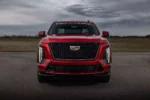Smooth Ride
The first thing when your car faces flooded roads is to determine the depth of the flooded area (not exceeding the wheel hub center). If the water level is higher than the center of the wheels, it’s best to turn back and not attempt to cross.
.jpg)
If the water level is low, your car may be able to cross. You should turn off all unnecessary accessories: air conditioning, in-car entertainment systems to reduce the load on the engine.
When crossing a waterlogged area, drive in a low gear (gear 1 or 2) and maintain a steady speed, avoid accelerating too much.
Do Not Restart
If the car stalls in the middle of a flooded road, the driver must absolutely not attempt to restart it. Restarting can cause the connecting rods to bend or worse, snap, fracturing the engine block due to the phenomenon known as “Hydrolock”.
Call for a Tow Truck
If possible, you should push your car to a non-flooded area and call for a tow truck. When calling for a tow truck, you should also have some basic information to avoid further damage to your car.
For example, for AWD vehicles and vehicles equipped with an automatic transmission, automatic traction control systems, automatic locking differentials, they should only be transported using a flatbed truck (4-wheel up).
.jpg)
In the case of front-wheel-drive cars, the tow truck should lift the front wheels. For rear-wheel-drive cars, the tow truck should lift the rear wheels.
While waiting for the tow truck, the car owner should proactively disconnect the battery to shut down the entire electrical system of the car, avoiding any damage when submerged in water, and push the car to a dry location.
Purchase Flood Insurance
When bringing the car in for repairs, you should clearly state the highest water level to the dealership’s technicians so that they can accurately assess the impact on the car and take reasonable measures to inspect and clean the systems.
Thảo Anh (TTTĐ)


































![[CAR REVIEW] Rolls-Royce Spectre: The Ultimate Luxury Experience](https://vnauto.net/wp-content/uploads/2024/02/xehay-rrspectre-30082023-1-100x70.jpg)

